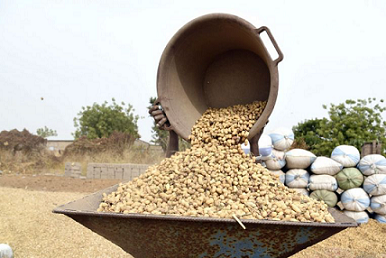
info.afrindex.com
China-Africa Trade Information Service

info.afrindex.com
China-Africa Trade Information Service

Image: straitstimes.com
West Africa, especially Senegal, once played an important role in the global peanut industry. In the 1960s, Senegal accounted for nearly a quarter of peanut exports. According to a 2017 World Bank report, peanuts are "the main source of income for the vast majority of family farms" and employ about two-thirds of the rural population.
Senegal was once one of the most significant worldwide players in the groundnut industry. After decades of decline due to ineffective policies and poor agricultural management, the West African country is now hoping to regain its former peanut glory.
Senegal has a "groundnut basin," in which most of the country's crop is grown. The basin covers a large swathe of central and western Senegal, north of Gambia. This area is large indeed: in 2010, over 40 percent of land under harvest was dedicated to the cultivation of groundnuts. Further, the groundnut sector both directly and indirectly employs about 1 million Senegalese people (close to 7 percent of the Senegalese population). Groundnuts typically require between 500 and 700 mm of rain to achieve good yields (this is similar to how much water corn needs to grow successfully).
The 1960s were very good years for Senegalese peanuts. At the peak in 1965, Senegal produced 1.1 million tonnes of groundnuts, and exported about 300,000 tonnes of them —which represented roughly 20 percent of total global peanut exports. In the subsequent years, Senegalese production began to slip, as the country’s former colonizer, France, lifted the price support it had been offering under the Lomé Accord. Meanwhile, global tastes in oils began to diversify as soybean oil, sunflower oil, and others became increasingly popular. China quickly filled the void left by Senegal and others, increasing production drastically thanks to agricultural reforms and the increased adoption of new varieties.
Over the next two decades, Senegal was only able to achieve strong groundnut production in 1974, 1978 and 1982. But after that, production trended downward, and was extremely erratic, so that the country did not again achieve production in excess of 1 million tonnes until 2000, and then again in 2010.
Large peanut orders from Chinese traders have cut Senegal's traditional selling season short this year, rewarding farmers with fat profits but leaving local buyers with slim pickings.
Peanuts are an important export in the West African state of Senegal, with the area around the central city of Kaolack a hive of production.
Chinese traders offer 300 CFA francs (S$0.69) for a kilo of unhusked peanuts, or 525 CFA francs for shelled ones, according to farmers and local officials.
China is itself a huge peanut producer, but demand far outstrips domestic supply.
Senegalese Agriculture Minister Moussa Balde said China has been the main buyer of Senegalese peanuts since 2014, when the two countries signed a deal.
The trade is also rising. Senegal exported 100,000 tonnes of peanuts to China in 2015, according to China's embassy in Dakar, rising to 200,000 tonnes last year.